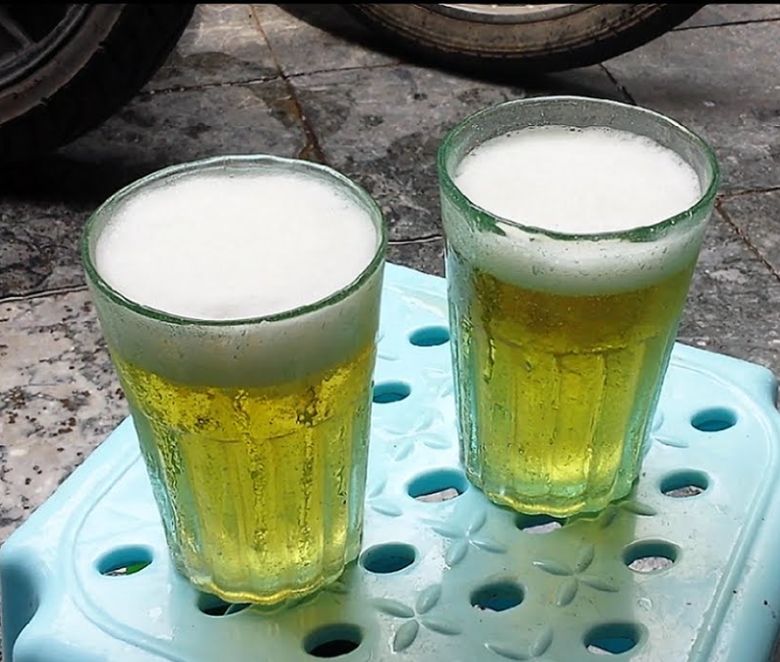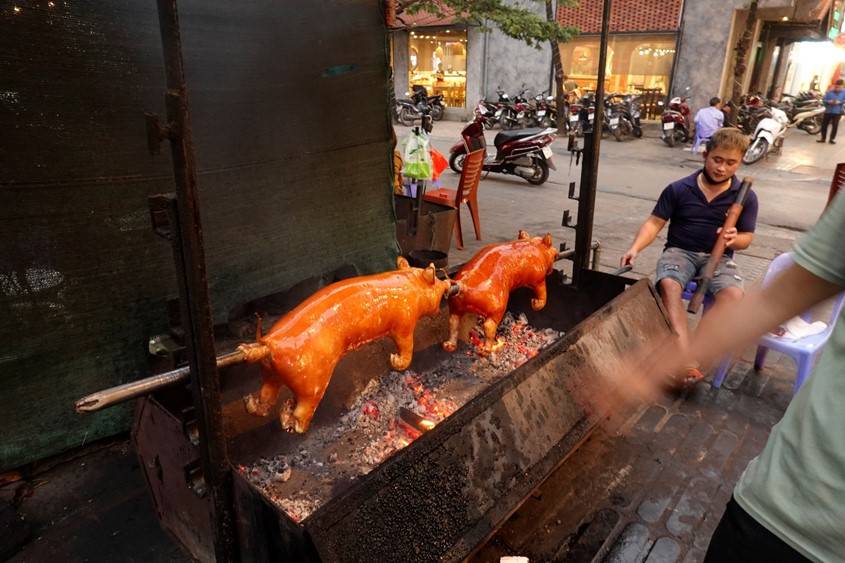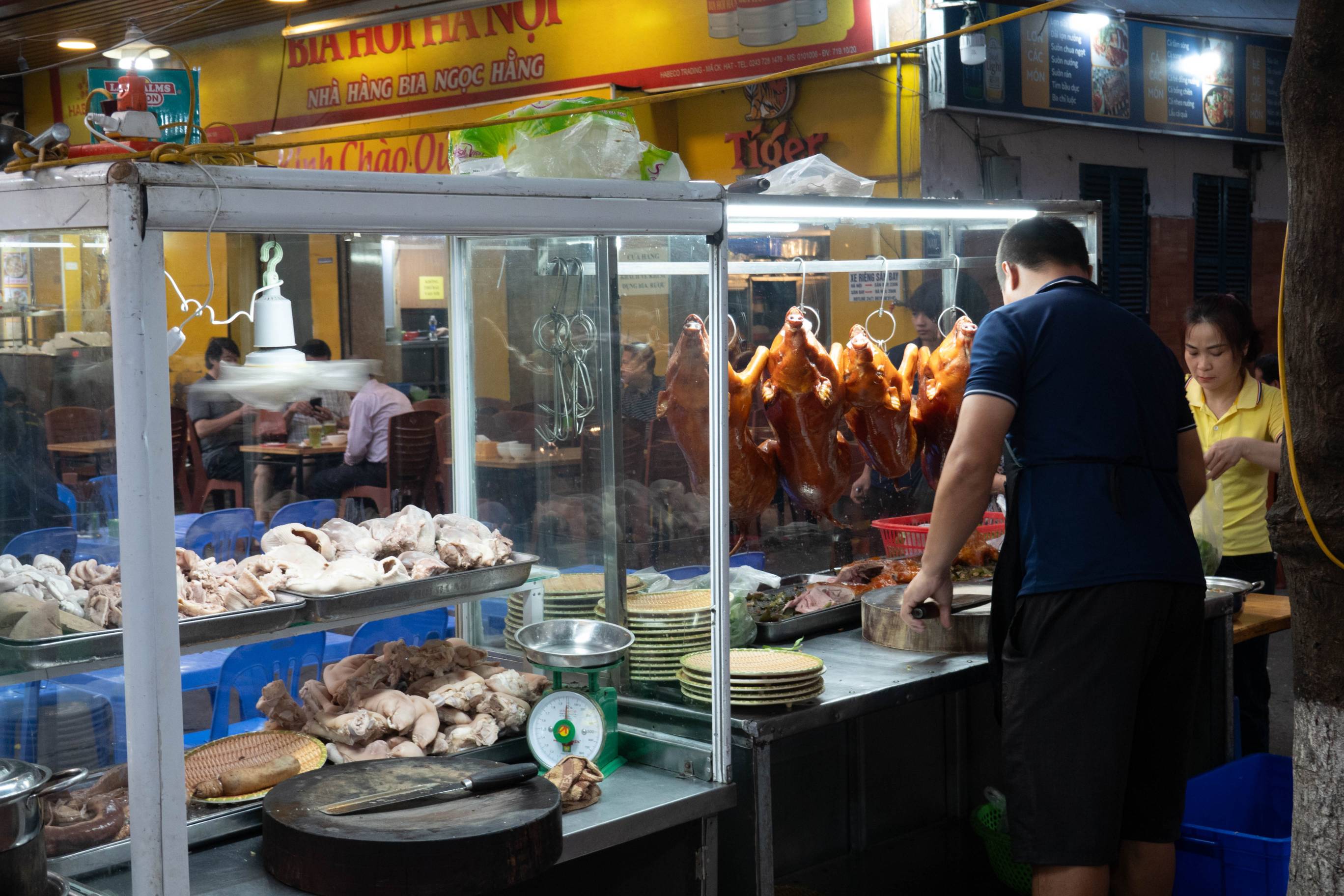Page 3
7/18/2024
Fresh beer? Steam beer?...
So let’s talk about an iconic North Vietnamese sight? establishment? landmark? feature? beverage?...“bia hơi”.
Disclaimer...when it comes to Vieatnam, much of the information on “the internet tube” seems to be people regurgitating something another blogger has said or written. In reality, it depends on who you talk to or where you get your information. Unlike many bloggers out there I try to talk to the locals and check for accuracy, but I hear many different things. This is what I’ve been told about bia hơi by my Vietnamese friends.
The word “bia” (pronounced “bee•ah”) is a calque of the French word “bière”; which means “beer”. Depending on who you talk to, the word “hơi” (pronounced as “huhoy”) means “fresh”...so “fresh beer” or “steam”...so “steam beer.”
Now, according to National Archives Centre N1 (https://www.archives.org.vn/gioi-thieu-tai-lieu-nghiep-vu/lich-su-130-nam-cua-thuong-hieu-bia-gan-lien-voi-nguoi-ha-noi.htm), the French first introduced beer to Vietnam in the mid-1800s. Beer production in Vietnam began en mass in 1890 when a French brewer named Alfred Hommel built a brewery in Hanoi.
To westerners, when you add the adverb “ở đâu”(“where”) to the words “bia hơi” as in “Anh Paul, bia hơi ở đâu?”, you can be using bia hơi as an adjective or a noun depending on context. Noun: “Anh Paul, bia hơi ở đâu?” – “Paul, where is the bia hơi (establishment) located?”; Adjective: “Bia Anh Paul, bia hơi ở đâu?” – “Paul, where is the bia hơi (fresh/steam beer; i.e. the type of beer) located?”. That said, due to the nature of the Vietnamese language and the way it is used, to the Vietnamese, in response to your question you would be directed to a location. After all, the location and the beer are one in the same – bia hơi is only available at the location...unlike other kinds of beer which are available at many locations.
To spin it further, the location that sells bia hơi also sells other types of beer, but unless you specifically ask for another type of beer, you will be served a bia hơi if you simply ask for a beer or sit down at the establishment. So if you sit down and say “Em ơi, cho tôi một bia” (“Give me a beer”) you will be served a bia hơi unless you specify otherwise as in “Em ơi, cho tôi một chai Tiger bạc” (Give me a bottle of silver label Tiger brand beer”). If you just sit down at a bia hơi you will be brought a bia hơi without asking, much like a wait person brings you a glass of water when you sit down at a restaurant in the US. After all, why else would you sit down at a bia hơi if you are not there to drink beer? It’s up to you to refuse the bia hơi if you want a different type of beer.
So let’s examine bia hơi the “fresh” beer. Bia hơi, is a low alcohol content draft beer that is brewed in 6 –7 days and it is not pasteurized (or is pasteurized depending on who you talk to) and does not contain preservatives – hence “fresh” brew – and it must be consumed within 1–2 days after production. This is in opposition to a “domestic beer” (e.g., Tiger, Bia Hanoi, Bia Saigon, 333 Beer, etc.) which takes longer to brew, is pasteurized, and contains preservatives so it will last up to a year. Bia hơi is ~2% ABV and most domestic is 3–4.5-ish ABV. Bia hơi is really cheap draft beer (about 7000 – 10,000 VND [$0.25 – 0.40 USD] per 12 – 16 oz glass) that comes in aluminum/steel kegs. What I’ve observed is the owner usually taps the keg with a typical tapping device and attaches a rubber surgical hose as a despenser. He just bends the rubber hose over to stop the flow and serves the bia hơi to people in a heavy, light green tinted glass or in a plastic pitcher with heavy green glasses. Bia hơi is usually served cold (they put a chunk of ice on top of the keg to keep it cold), whereas domestic beer sold at a bia hơi is served warm, in non-tourist places, with a small bucket of ice on the side for those who wish to cool it down. FYI: Vietnamese usually consume their beer warm. Bia hơi does not use much, if any, hops in the production process, so it is less bitter (hopped) than domestic beers so it has a “cleaner” (i.e., fresh) taste.
Insert fun fact here – I have never seen Vietnamese drink beer (or water) from the can or bottle when in groups. Beverages in bottles/cans are communally served. Someone pours a little beer into everyone’s glass (never a full glass, generally about ¼ th of the glass) from the same bottle until it is empty. When the person is done drinking their share, more beverage is poured into their glass from the opened bottle or a new bottle if that one is empty. The wait person then tallies up the number of empty beer/water/soda bottles and adds the charge to the bill. Even at a meal, if you have a soda and someone else has a bottle of water and someone else has a beer. People always pour a little into their glass to drink and refill from the bottle. If you order a soda at a restaurant they will bring two or more cans/bottles and count the empties at the end of the meal.
So what’s bia hơi the “steam” beer? It’s exactly the same as bia hơi the “fresh” beer. “Steam beer” is a type of western beer. Although the origin of the moniker has been lost to time, it is a light lager beer that got the name “steam” from either: the cooling process used or the sound of the beer when opened or the bubbles in the beer or whatever...like I said...really its origin is lost to time.
Here are two glasses of bia hơi sitting on top of the iconic small 10 “ square by 10" high, four legged stool. The stools are both tables and chairs.

Here is a picture of bia hơi on its way to a bia hơi. The three kegs on the top show the top of the keg where the tap goes. What you see is the quintessential “beer delivery truck” of Vietnam.

So let’s talk bia hơi, the location. A bia hơi is an outdoor pub-like place that exists every few blocks where people (mostly men) in the neighborhood hang out. Some have an inside section that is air-conditioned (barely). They all serve food (of all kinds). Unlike food at western “pubs”, where food is expensive, food at the bia hơi is very, very cheap but typically of very good quality and a huge variety. The bia hơi near my house is one of the few that serves roast piglet and it is very popular in my area of town...always a million people there when it is open! I think it is known for it’s roast piglet. People usually stop at their local bia hơi on the way home from work to either have a few beers, have a few beers and eat some food, or go there to celebrate some event (birthday, winning the lottery, a business deal).
The cook below, who is the owner’s son, roasts the piglets at one end of the bia hơi so the smoke doesn’t get in the customer’s face.... the cook is holding a water pipe and is smoking a tobacco that has a high nicotine content that has a mild stimulant affect.

When the piglet is done roasting, an employee carries it down to the prep cook to be chopped up for serving...

Below the prep cook, who is the owner, is preparing to chop up the pig. His wife is bagging up some leafy veggies to put on the tables. All the white meat on the left is the boiled stomach, intestines, snout, feet, and ears for those who don’t want these items roasted. If you look to the right of the chrome pot in the lower left hand corner you’ll see a sausage that has been made from the pig’s blood. It has a really rich and strong iron-like flavor. The fan keeps away insects. Not sure what the mix the blood with? They will sell all of this pig by nights end and this is in addition to all the other pork, beef, chicken, goat, snail, tofu, rice, eel, and hot pot meals you can buy. They have at least one hundred different dishes they serve. The Vietnamese rarely eat a single dish (other than Bún Chả or Phố) they order multiple dishes and eat it all family style. In the picture below, the background on the wall in red and yellow you see: “Bia Há Nòi, Nhà hàng bia ngọc hắng” this translates to “Ha Noi Beer. Pearl beer restaurant” this means the bia hơi sells “Ha Noi Beer” a domestic brand, and the owner calls the place the Pearl beer restaurant. You can also see the “Tiger” brand beer sign under the silver kegs.

Below is a google map screen grab of the place near my apartment. You can see that when they took this picture it was during the early part of the day (nobody at the bia hơi [inside red square]). In the red circle, behind the guy on the motorbike, you can see someone is already roasting pigs for later in the day when they open up. The red “X” marks the spot where the piglet is chopped up. The people sit in front of the building inside the red square or go inside where there are two large rooms with AC and fans. The place will easily seat 200 people.

Here is another bia hơi on the way to the supermarket where I shop for groceries every week. Note there is a glassed off room upstairs which will have AC. The stools/tables out front have not been put out. This picture was taken at about 08:00 in the morning.

NOVEMBER p.2, p.3, p.4, p.5, p.6, p.7
DECEMBER p.2, p.3, p.4, p.5 p.6, p.7, p.8
MARCH p.2, p.3, p.4 p.5, p.6, p.7
APRIL p.2, p.3, p.4, p.5, p.6, p.7, p.8, p.9, p.10, p11
May, p.2, p.2b p.3, p.4, p5, p.6 p.7, p.8